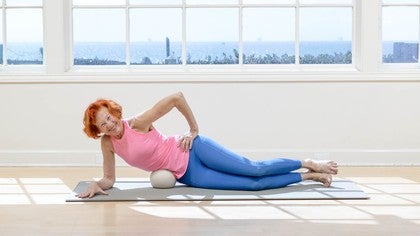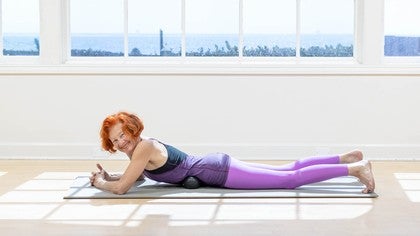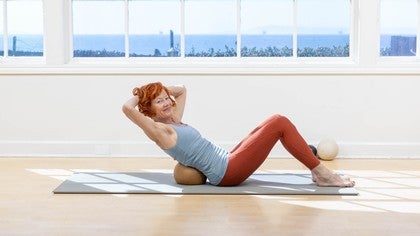Description
Props Needed: White Yamuna USA® Ball or something equivalent.
About This Video
Transcript
Read Full Transcript
Welcome to the External and Internal Obliques. This is a fabulous group of muscles that wrap around, and we will start with the external obliques. The external obliques create this pulling in, they limit flexion of the body, and they stabilize and limit rotation of the spine, but allow for rotation of the trunk. Very interesting. Create stability in the middle, and facilitate movement on the outside.
A lot of us talk about how we're short waisted and quite often, that can be dramatically shifted when you roll out the obliques and you start to create more space. When these muscle groups get tight, and restricted, or have adhesion, and the fascia is pulling, and limiting the potential of the movement, very often, it creates compression in the lumbar spine and then you have another condition. So each one of these muscle groups is so exciting because it really plays a part in potentiating and freeing up our anatomy, so that we can live in a more optimal state. And it gives us a skill to do it ourselves. The routine we will do, I'm working with a medium-sized ball.
Again notice, not too hard, not too harsh, because I want to really allow for the softening and the elongation of the spine. We will be starting right up in the rib cage area underneath the shoulder blades, and then rolling across underneath the ribs. When we get to the front and coming down, we want to constantly be working into this spatial area. Then we'll go into the central ribs in the back and roll through towards the waist and then lower down just to the lower part of the ribs, moving down into the iliac crest, and all the way down to the pubic bone. In the front, you will have your rectus abdominis, and they attach these external obliques come in there.
So we're not going right to the middle, but if you do, nothing will happen negative. (laughs) Because that's a wonderful thing about this. If you're globally in the area you start to get the results you want. We will start on the right side, remember, near the shoulder blade area, so not in the middle, it's kind of out there, and lay down. This is where a lot of the origins start, of this muscle, big muscle group. So take a moment, soften this area, feel into it, allow the ribs to start to release, and receive the pressure.
Take a breath in, and on the out breath, start rolling to the side. So we're rotating into the side ribs and angling down into the soft tissue below the ribs. So I'm now still touching the ribs, but I'm on the side. Take a breath in here and then start to keep rotating the body. Now I'm in my waist area and this is a very key area.
I'm lifting the ribs up. I'm expanding them so my diaphragm is over the ball, not on top of the ball. I want that space. Take a breath in here, elongate the waist as best as you can, and then start slowly rotating further towards your belly. This is where...
There can be compression, there can be tightness, there can be resistance. You can feel really, really tight here. So good to start to make space and elasticity and mobility. Take a moment to allow the tissue to soften. Check that you're still breathing.
Check that you're opening up this area by the position of your own anatomy. Take another breath in. Breath out, and roll a little bit further into the front. Remember, you're not on your ribs. You're below the ribs.
You're allowing yourself to sink into the soft tissue and this soft tissue can be quite tight fibrous and rigidified. So take your time, let's take a moment here. One more breath in. If it's very extreme, I push my belly out into the ball. And then as I breathe out, I lift the ribs.
And see how much can I soften and receive the ball. To soften and stretch out this tissue, allow it to decompress, change its program and upgrade. And then come off, move back and place the ball lower down, not on the tip of the shoulder blade, but further down. So you're right on the ribs. Take a moment.
I'm on this diagonal, (chuckles) allow those ribs to soften. This is where those obliques are attaching. Think of it, this huge muscle that pulls the ribs in, that compresses the abdomen, that limits flexion of the spine. It's really amazing what they do. And to create...
Basically, the ultimate goal to create stability and mobility. So we want all of that. Take a breath in. And as you breathe out, start rotating towards the side. I'm not fully on my side yet, but I'm focusing, and making my back ribs pull away from my waist area, and encourage this wrapping feeling of the muscle.
It goes from the back into the front. It's like hugging your whole body. Big breath, pull those ribs away from your waist and roll into your side. So now, here we go again. We're really looking to get as much space in between the hips and the ribs that we can.
Be sensitive that you're not pressing strongly into your ribs, into the ball. 'Cause they're a little bit more fragile. We want to be under the ribs, into the area of the diaphragm. Take a breath. And on the out breath, roll further forward, and start to roll towards your belly.
Towards your navel. Take your time. Breath in, breath out, lengthen your waist, and pause here. So now, we're at the area, where the muscle will be attaching to your rectus abdominis and you want to allow the muscle to shift and breathe and decompress. Take a moment to feel in.
Let this area shift, open it up. I'm rolling a little bit more unto my belly to create more space. And then come back off. And now move yourself down into the lumbar. I'm here.
Lumbar area, iliacus, top of the pelvis area. Press into this area. So now, we're stimulating the pelvis. And take a breath in. Inflate and roll to the side.
So again, we're top of the pelvis now. We're into the bony structure and we're into the waist. So you can, if you want to work further out to create that length in the side body, and start to roll even more towards your belly. I'm now completely on my side and feeling into this tissue, which can get very fibrous and tight and strong. And I like it to be tight and strong, but I want more space in it.
It will help open up the lumbar spine. Another breath in, roll further forward, starting to rotate down, and aim yourself on a diagonal from your hip, or your front hip bone area down towards your pubic bone. So you will slowly roll across the bone into your belly. Big breath in, breath out, sink, and roll the ball down. Now you should be in the soft tissue.
Again, an area that if you haven't done a lot of work can be sensitive, but it will soften and release. And then roll yourself all the way down to the pubic bone. So you feel your pubic bone top right corner, and you're pushing the ball into it. You're creating traction in this area. You're lengthening the fascia, softening the attachments of the muscles into this area.
Take a moment. If it's very sensitive, spend more time here. Seriously, each of us is different. Sometime we can start to open up an area and it can have a lot going on. So you want to take time and care for that area.
It will dissipate and even out and calm down and you will do a huge, huge service for your physiology. Roll onto the pubic bone and come on off. Just sit up for a minute. Check yourself. (laughs) Sometimes, this side can be much longer, and we will get into the other side now. So starting out, close to the shoulder blade on the left side.
So it's kind of halfway between the spine and the side of the ribs. You want to soften this area. Take a breath, inflate the area. As you breathe out, begin rotating. So I'm rolling on a diagonal down towards the back side of my ribs.
Big breath in. Breathing out, rolling further. Now, I'm in my waist area. This is where you use your hands, you use your positioning to create space. This is the area that gets really tight.
Also, allow yourself to lift your diaphragm up in front. We want to open up this area and expand it. Another breath in, and rolling forward below the ribs. So we're coming under the ribs in the top belly area. Take your time.
Lift the ribs up away from the ball so it rolls under the ribs. We don't wanna be rolling on the ribs as much as under the ribs. Take your time. This can be sensitive. It can be tight.
If you want to, you can do micro movements back and forth to feel into the area. Another breath in. Lift the diaphragm even more, elongate that waist area and roll a little tiny bit further forward. So we're coming a little bit more towards the front of the body. We're wrapping that corset around, creating traction.
Wait, if it's tight. Just literally wait, listen and pay attention, honor what's coming back to you as feedback. This is your body. This is what's going on. It's amazing what happens when you become a team member with your own body.
Come on off. And starting out a little bit lower down. So we were up high halfway down the ribs, still in the bony structure. Take a moment to listen to when your body says, "Yes, I'm letting go. I'm ready to receive the pressure.
I'm loving this relaxation." It actually does happen if you listen. From here, with nice, rich breathing, start to roll yourself on a diagonal down and to the side. So we are getting into the corner of the ribs aiming downwards. And this is where you can start with your imagination. How much can you create space between the hips and the ribs?
How much can you open this area out? And then roll into the space on the side of the body. So we're wrapping around and we're allowing the hips and the ribs to start to separate out. And then start to roll further forward towards your center line or the midline or your navel. Although, we're not going that close in.
Take a moment. Really pull the body apart, see how much space you can make between the ribs and the hips. Big breath will help you open up over and over again and make more space. It's like the swell of the breath creates a traction and a movement in an area of the body that can be very tight. Use that to amplify the effects of the work.
Roll further forward towards the belly. I'm not going right up to the midline, I'm halfway between the side and the front, separating the ribs, separating the hips, and allowing the body to sink, and embrace the ball, and traction out the tissue. Take a moment to open up this area a little bit more. Notice what you're feeling, and then we'll come back for the third part. So lower down into the top of the pelvis and the waist area.
Take a moment here, and start to roll across the top of the pelvis. So we're stimulating the waist, we're stimulating the bones of the pelvis, we're pulling the ribs away. If you want to expand and just check into what is happening, you can drape yourself over a little bit more. Come back up, roll a little bit further forward. Coming into the front part of the pelvis, allow the bones to soften.
And then start rolling off your hip bone into the flesh of the belly, angling in towards your pubic bone. So take your time here. This can be sensitive if you haven't done this work before. If you have, the body just goes, "Oh, bring it on. I love the feeling." So pain is very often stuck stagnation in our bodies.
Our bodies love pressure. They love expansion and contraction. They love stimulation and the tissue is very resilient. It's designed to receive pressure and shift. So keep gradually bringing yourself down towards the pubic bone.
You're moving on a diagonal from your hip bone to your pubic bone, and then drag yourself all the way up. So you can feel that final area, where the attachments occur into the pubic bone. You want to be having that concept of pushing it downwards, lengthening it. If there is sensitivity here, good place to spend more time and breathe. A lot of things can be going on in this area.
We store a lot in our tissue and it can shift things extensively. So take one last breath in into this area. Breathing out, release even further, and then come off the ball, lie down on your backs, and see what you feel like, see what your waist feels like. Do you think you're taller or longer? Just take a moment to check in.
And then when you feel ready, bring yourselves again to a seated position to check how you feel when you are seated. Does your waist feel longer? Do you feel your posture has more of an uplift and you feel actually lighter? Like, the body doesn't exist, that's really what we're looking for. This lightness in the physiology.
We're going to be rolling out the internal obliques now, which are relatives of the external obliques. Again, they stabilize the spine, contribute to rotation, make sure that you don't get, how can I put this? If they get too tight, which is very common, the ribs and the hips get too close together and then the lumbar spine gets compression, which means you don't have easy rotation right and left, or side to side, turning your head. So they stabilize the spine actually but they allow for rotation of the pelvis when they're healthy and they create space and they allow the lungs and the ribs to move. So how are we going to roll them out?
We're gonna start at the pubic bone, roll up to the hip, and roll across the crest of the pelvis to the back and then roll across towards the belly. We're going to move a little bit higher up into the lumbar spine area and wrap around. And then one more time higher up closer to the base of the ribs. And again, wrap ourselves in. So this is more like a wrapping corset feeling.
We will start on our pubic bone. Let's start right at the center, and then from there, feel the pressure, and roll slightly to your right side. Take a moment, take a breath in. Breath out, support your body with your abdominal area if you can. You want to avoid really dropping in the lumbar spine.
So a little bit of gentle support. For some of you, you can put a ball under your belly or under your chest to help you hold the weight. And then from here, roll towards your right ASIS or right hip bone. So you're going to traverse down and take a moment to allow that area to decompress. Big breath in here, breathe into the ball, breathing out, sink into the ball, and start to rotate higher.
So now we're riding the crest of your bones towards the side. Notice that the ball is large and maybe you're starting to feel the ribs. Can you lengthen the ribs away? Feel the pressure and start spiraling around towards the back. Take a breath in and traction the ribs away from the hips and roll a little bit further around.
So we're just taking this journey around our pelvis because this is where those obliques attached. This is the origin. They then extend from these bony landmarks. So you're going to get halfway across towards your spine, but not quite. Take a breath in and then stay on these bony landmarks and start to roll back.
So you're staying on the pelvis, moving towards the side, lengthening your waist, and very slowly and consciously, roll through into the belly. So you're rolling probably a little tiny bit below your belly button, in and softening into that area. Take a moment. Remember, you're wrapping this muscle around, elongating it, stimulating it to restore its native state. Then come back, place the ball in the lumbar spine area, halfway between the spine and the side of your body, lift the ribcage away from the hips and then go back into the ball.
So we're making space, as always. And slowly, lifting these ribs up, start rolling towards the side, elongating, separating the ribs from the hips. If your ribs are very tight, you can always work with a smaller ball or lift up more. So you're not putting heavy, heavy pressure on the ribs. You're putting pressure into the pelvis and in the waist.
Keep rolling around. It's like you're moving through molasses, stretch this area out, creating traction, and stimulating the tonality of the muscle. Big breath in, roll further towards the belly, allowing yourself to sink into the tissue, and open the space up. Take a moment, and then go back one more time a little bit higher up. So a little bit further, we're coming into the area of the ribs.
You want to be sensitive here. Don't use heavy, heavy pressure. This is the area of our floating ribs. Big breath in, angling yourself across, feeling the tissue open, lifting the ribs away from the hips, rolling onto your side, and then rolling across under the ribs towards your midline. So again, we're wrapping ourselves around, and notice at the beginning and ending of these little wraps are slightly different from the external obliques.
Then come off, and we'll start to the left side. So place a ball on your pubic bone again. Take a moment to stimulate the center, feel the pressure, and then move on to a diagonal left side of the pubic bone. Allow it to soften and release, and start rolling on a diagonal towards your ASIS or the front of the hip bone, the bony area. Take a moment here.
Lengthen the ribs away from the hips, and start journeying across the pelvis. Take your time. You're riding the crest of the pelvis and moving across towards the back. So this is where all the muscle shaft is at the origin of it is. Very important to stimulate this area, and wake it up, get in touch with it.
Take a moment here. Take a breath in and start rolling back across the top. Opening the tissue, stimulating the bone, allowing for pressure, and very slowly, in your own time, as though you're going through molasses, roll towards the belly. (laughs) I sometimes feel like I'm pushing some kind of kneading clay and moving it nicely, and slowly shaping it in another way. So enjoy the feeling.
Then come back, and we will move into this area of, not on the spine exactly, halfway between the spine, and the side of the body in the lumbar area. Feel that area soften, separate the hips, and the ribs to the best as you can. Take a breath in, and on the out breath, start rolling your waist out. Separating it out, lengthening and making distance between the ribs and the hips. The hips can take full pressure.
The ribs, you want to be respectful of. You want to keep lifting them away and letting them receive light pressure, but not full pressure. So support this movement with your hands. Keep rolling through, keep creating this lovely, beautiful spaciousness. Your waist will be so gorgeous.
You will feel so lovely after this routine. Rolling through towards the front of the body. Let yourself take a moment here to receive the pressure. And then go back again. And the final one, starting halfway between the back and the side of the ribs on the low rib area, just feel into that area.
Remember, we're not looking to take full pressure here, we're holding pressure with our hands and rolling through angling a little bit down across the side, making sure the hips are pulled away from the ribs, and rolling towards the belly, or right under the ribs, ironing out any constriction. Sometimes, you can feel little areas, where the muscle is so tight. It's like a cord and it starts to ease out. Remember, we're like getting everything fluid, and so all these different fibers move easily in relation to each other. We don't have any glued up, tight stuck tissue.
All the way through. And then when you're ready, you come off, lie on your backs. Again, check what your waist feels like now. What your back low ribs feel like now, how your hips feel like now. (chuckles) Very often, there can be a significant change in the size of the body. Sometimes, people get half an inch taller, and much more lean looking, because it opens up, decompresses so much.
Bring yourselves up to a seated position. And again, see what you feel like. When the body decompresses, there's a lightness. Lightness of spirit and lightness of sensation. And when you walk around today, notice how you feel, because you probably will notice a difference.
There should be a lot more fluidity and mobility between upper body and lower body and it should feel good. So I hope you will experience this. Thank you very much.
Release Your Fascia: Upper Body Freedom
Comments
Kerry H ,Niamh O ,Copycat thank you all for your comments. So glad you enjoyed this. Kerry, there is a video at the beginning of the series where I recommend the props to purchase. You can order a full set from me if you like: or follow the links in the description.
You need to be a subscriber to post a comment.
Please Log In or Create an Account to start your free trial.














